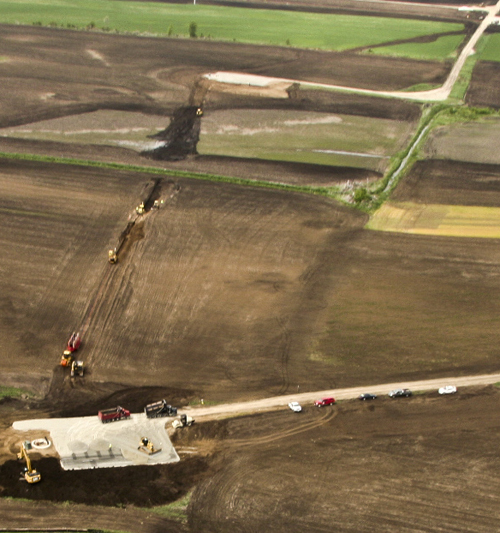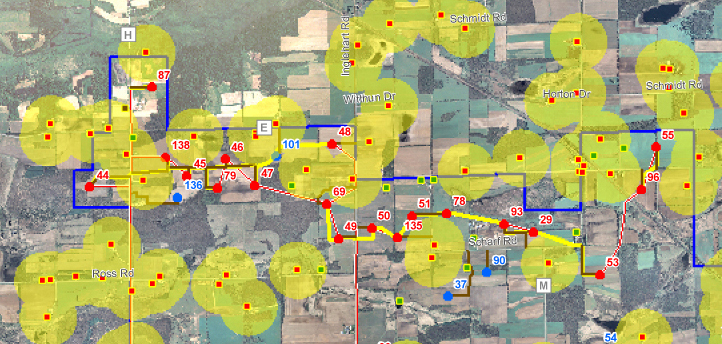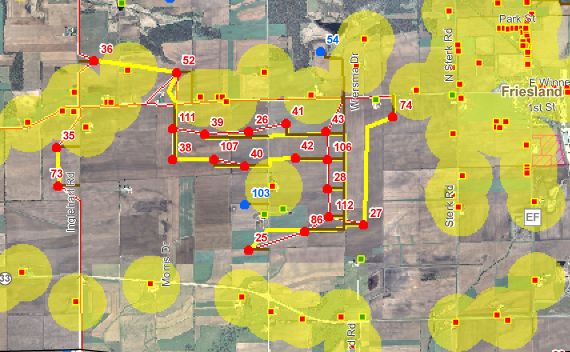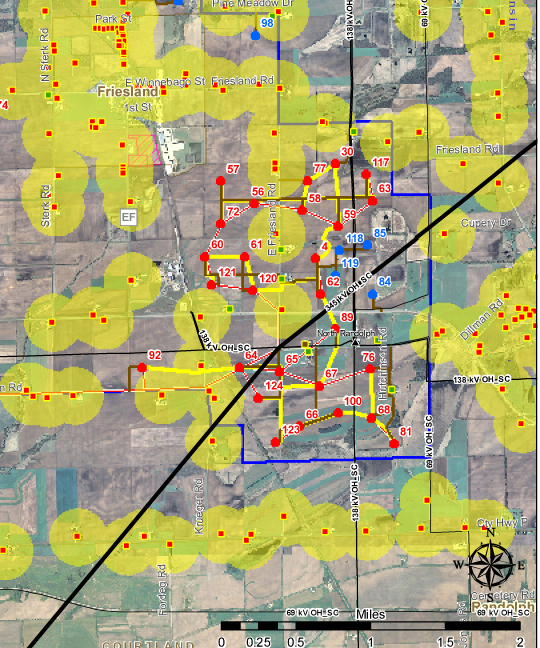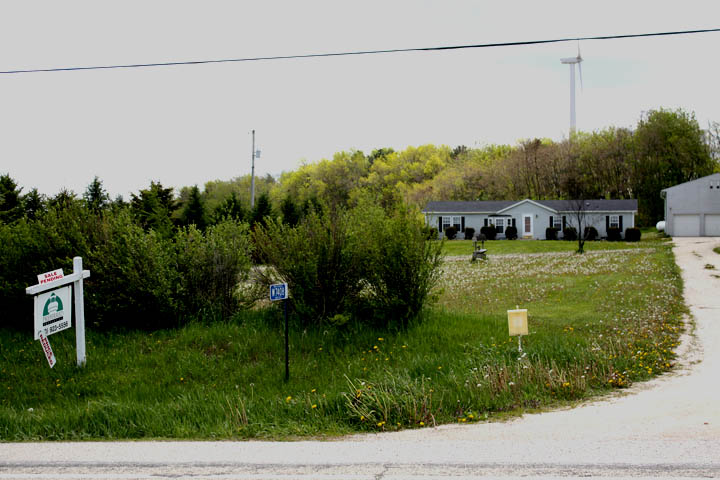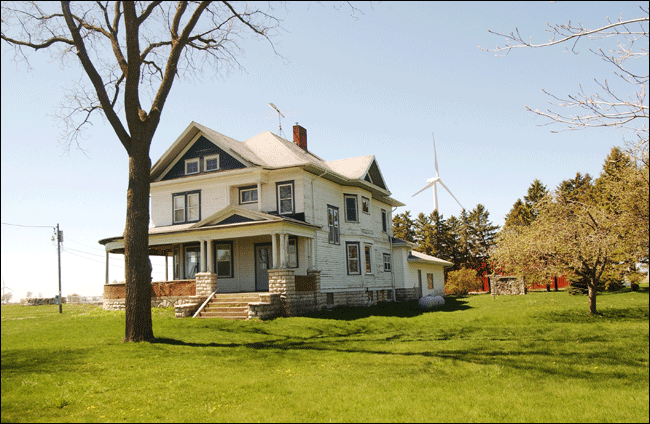Entries in Glacier Hills Wind Farm (5)
5/31/11 Wind Farm Strong Arm Chapter 4,358: From Ontario: Message to wind company AND Columbia county towers going up.
FROM ONTARIO
'GET OUT'
“You’re fighting a losing battle, just get out,” one resident shouted.
The company has received approval from the city to build eight turbines on the mountain range, after threatening a $126-million lawsuit when city officials in October rejected the location of several turbines.
Instead, community members lined up to voice their opposition to the project. Some told stories about what the mountain meant to them and others gave promises to stand against Horizon no matter what.
“You’re fighting a losing battle, just get out,” one resident shouted.
Jordan Morriseau, 30, usually hunts in the fall and said the turbines would impact his traditional hunting grounds and cause damage to endangered species that live on and around the mountain. He’s fighting against the project for environmental and cultural reasons, he said.
“That’s prime moose habitat up there,” Morriseau said. “We live off moose, it’s one of our main foods. The wind farm would be detrimental to our way of life.”
The company has received approval from the city to build eight turbines on the mountain range, after threatening a $126-million lawsuit when city officials in October rejected the location of several turbines. The project must still meet the standards set out by the province, through a renewable energy approval application. The province has already rejected Horizon’s REA application once.
Alex Legarde shared Morriseau’s concerns about the project. Legarde said he had questions he wanted answered, wondering if building the turbines would destroy hunting grounds. He’s concerned because hunting and trapping are his livelihood, he said.
Legarde hoped the project wouldn’t go through, he said.
Shane Wells, 31, went to the mic to speak a few times. He said he doesn’t know much about wind turbines, but he does know his community doesn’t want them and felt the two spokespersons for the company didn’t care what the community had to say.
“They could have put an audio recorder down and said see you all tomorrow and I`ll take that back to my boss,” Wells said. “I`ll give them the recorder of what was said. Oh they don’t like it, well just throw it away.”
Wyatt Bannon, one of organizers of the meeting, said he’s just one voice of many representing people who oppose the project. Horizon Wind is trying to build in an area that is sacred to the community and that development has to stop, he said.
No matter Horizon decides, the community is prepared to do to stop them, he said.
“We`ll do whatever it takes,” Bannon said. “We will not let it happen. Anybody to even consider putting those things up in such a pristine area are ignorant to everything people have worked. You don’t go into a watershed. That’s a no-brainer. It’s to protect the water. For these guys its money but for us it’s a lot more. It’s life.”
Following the meeting, officials with Horizon Wind weren’t available for comment.
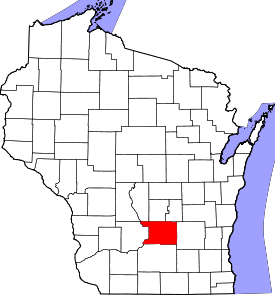
From Columbia County
WIND FARM TOWER SEGMENTS READY TO GO UP
May 31, 2011
By Lyn Jerde
“We’re building a project that not everybody wants in the community,”
TOWN OF SCOTT — How’s this for irony? The construction of the state’s largest wind energy facility is on hold, on account of wind.
The towers - the lower two components of them, anyway - were supposed to start piercing the skyline of northeastern Columbia County this week.
Instead, the components were, as of Thursday morning, lying on their sides, while the anemometers at the top of the cranes clocked wind speeds at about 40 mph. That’s about 15 mph too brisk for the safe construction of the towers.
It’s no surprise to Mike Strader of We Energies that breezes can get a tad gusty in these parts. That’s a key reason why We Energies is building the 90 turbine towers that will comprise Glacier Hills Wind Park on about farmland occupying about 17,300 acres in Columbia County’s towns of Randolph and Scott.
But, if the wind gusts to 25 mph or more, as it has all week, it’s not safe to erect the towers.
“What we can’t do is what we would love to do - put up those towers,” Strader said.
Starting Monday, plans had called for the arrival of the components of eight towers per day. The four segments of each tower would arrive, one at a time, from Manitowoc on trucks with about eight axles to distribute the weight evenly.
Many of the turbine blades have already arrived by rail from Colorado. Most are being stored, for now, on a town of Courtland parcel approved by Columbia County’s planning and zoning committee as a temporary staging area for the Glacier Hills project.
We Energies spokeswoman Cathy Schulze said that, for the most part, gawking at the construction will be discouraged, for the safety of the public and the workers, and because much of the technology is proprietary.
But the curiosity is understandable, she said, and an open house Wednesday is intended to satisfy that curiosity.
“A lot of people want to see these things,” she said. “This is a very good way let people get up close, without jeopardizing themselves and others.”
Strader said it had been hoped that at least the bottom two sections of a tower located near the construction office on Highway H, in the town of Scott, would have already been up by the time open house guests arrive Wednesday.
That doesn’t seem likely, given recent windy conditions, but it’s possible that people could see the components hoisted up Thursday.
Starting in the southeast quadrant of the construction area, Strader said, the base and “lower mid” segments of towers will be put up first.
The base component can be identified by a flange that sticks out around its bottom circumference. That’s the part that will be in contact with the ground, and held in place by grouting.
About six weeks after the bottom two segments of a tower go in, the top two segments will be installed. Also installed will be the nacelle (an enclosure at the top of each tower that contains the generator and transformer), the hub and the three blades.
The project is due to be finished in December, Strader said. He added that the wind delays so far have not put the project too far behind schedule - though there may be times when weather-delayed weekday work might have to be made up on Saturdays.
And yes, he said, some area people have let Glacier Hills construction workers know - sometimes by honked vehicle horns or shouts from vehicle windows - that they’re not happy about having 90 400-foot towers going up near where they live.
At the public hearings held before the Public Service Commission of Wisconsin authorized the project - with conditions - residents raised health-related concerns. Concerns include low-level noise and shadow flicker, as well as loss of TV reception, dangers to birds and bats and challenges for landing helicopter ambulances in the project’s vicinity.
“We’re building a project that not everybody wants in the community,” Strader said. “But, if alternative energy is to be produced in Wisconsin, then wind is one of the most viable resources.”
Want a closer look? Open house set Wednesday
The public is invited to take a closer look Wednesday at the construction of Glacier Hills Wind Park - including the big components of the 90 wind turbine towers that are going up in the towns of Scott and Randolph.
We Energies will have an open house from 3 to 7 p.m. Wednesday at the Glacier Hills construction office, N7844 Highway H, about a half-mile south of Highway 33 in the town of Scott.
In addition to viewing components and construction equipment, participants may sign their names to a turbine blade.
Officials of We Energies will be there to answer questions about the Glacier Hills project.
By the numbers
14: The approximate diameter, in feet, of the hollow space inside one of the Glacier Hills Wind Park towers, where there’s a ladder by which maintenance workers can access the towers.
138: The weight, in tons, of each completed tower.
148: The length, in feet, of each of the three turbine blades on each tower.
410: The height, in feet, from the ground to the top of the highest-reaching blade.
3: The number of quality checks that each turbine must pass before it’s operational. The turbines also will be inspected for safety periodically once they start generating electricity.
4: The number of sections in each tower.
56: The number of miles of underground trenching for the electrical distribution system within Glacier Hills. A lot of that is along Highway 33 just west of Cambria.
8: The number of axles on a truck that hauls a single segment of a turbine tower.
100 to 105: The number of feet high that the bottom two components of a tower - the base and the “lower mid” - stand once they’re assembled.
2: The number of towers per day that We Energies had hoped to build, starting Monday.
0: The number of towers that have been built as of Thursday.
10/14/10 On being a red square in a yellow circle: A wind siting council member weighs in on the real cost of Wisconsin wind farms AND Wind Turbines Too Loud? Sorry Charlie, ain't a lot we can do for you now.
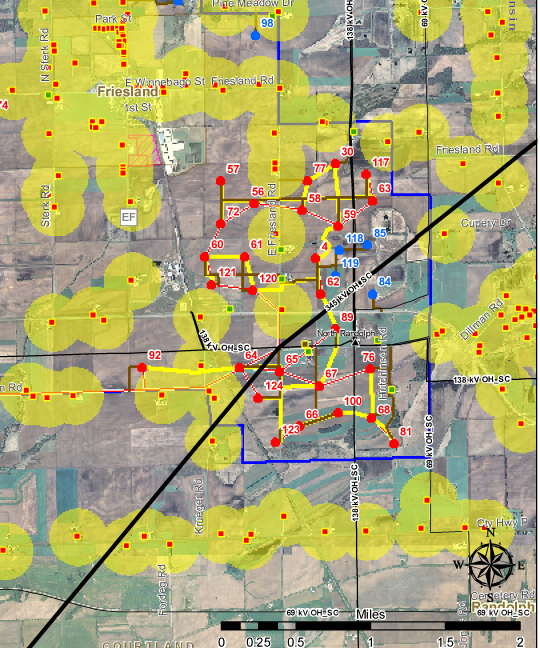
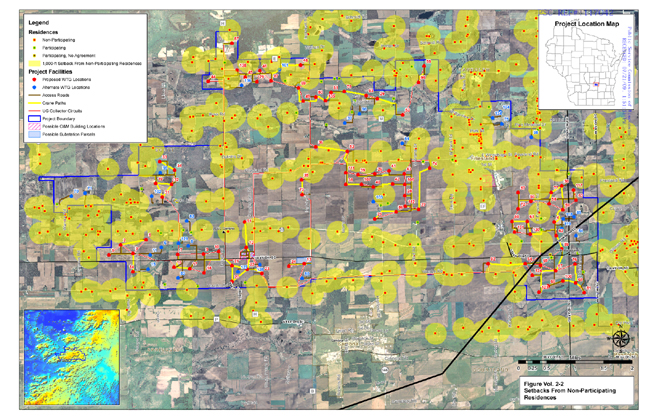
HOW MANY RESIDENTS WILL BE AFFECTED BY THE NEW WIND SITING RULES?
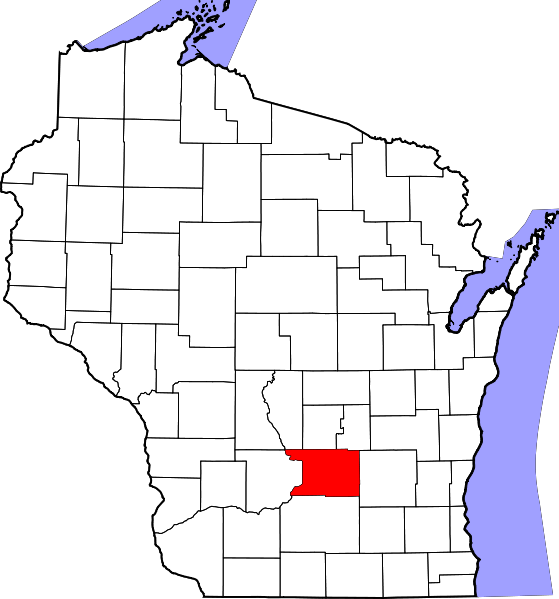
The red squares in the yellow circles on the map above represent non-participating homes in the WeEnergies Glacier Hills wind project currently under construction in Columbia County.
The larger red dots are the turbine locations. [Scroll down to see more detailed maps.]
The new wind rules adopted by the Public Service Commission have the same setbacks from homes as were used for this project.
One difference is the PSC required WeEnergies to offer to buy two homes in the project because seven turbines were to be located within half a mile.
The new rules do not include this sort of protection. Chairman Eric Callisto said by law homeowners have the right to sue the wind developer/owner and he felt that was all the protection they needed.
Although Wisconsin wind farm residents who have been forced to try to sell their homes because of turbine noise and shadow flicker have found no buyers, local wind developers say 400 to 500 foot tall wind turbines located less than 1500 feet a home have no impact on property values.
[CLICK HERE to watch Wisconsin Eye video: During the panel discussion, WPPI vice president Dan Ebert and WeEnergy's head of wind development Andy Hesselbach explain why turbines do not affect property value. ]
Or CLICK HERE to link directly to the Wisconsin Eye 'Newsmakers' feature "Future of Wind Energy"
Developers also say Wind energy is the cheapest way to get renewable energy and cite surveys which indicate stong public support for wind power.
Wind siting council member and Wisconsin realtor Tom Meyer weighs in on the matter.
This is not a question of whether or not people like, or favor "wind" as the lobbyists try to argue. Everyone likes wind, sun, water, earth.
The issue is this: The total cost of generating energy by the use of 400 and 500 foot tall turbines in Wisconsin’s rural communities.
Developers admit that they cannot get investors, who are primarily foreign investors, to put their money up unless the costs of access to the land are depressed.
To get the biggest area to install the highest number of 400 to 500 foot tall turbines, the developer needs to have the greatest access to the most land and compensate the fewest people with the least dollars.
The developer does not need your land, he needs to get one foot [away] from your land.
Every foot the developer is made to move away from a landowner whom he does not have to compensate, adds cost to the developer and reduces the bottom line to investors.
Every dollar spent to gain access to the right to disturbing the peace of a landowner reduces the bottom line.
For wind turbines to be profitable, the industry could improve the technology or depress the cost of access to the land.
By their actions, they prove they believe depressing land costs is more favorable than investing in improving the technology.
Their answer to improved technology is taller and more intrusive. That's not a real solution.
If the turbine can't produce energy without imposing on neighbors, there is no reason to spoil the earth, and threaten the water, and block the sun, to catch the wind.
-Tom Meyer
Wisconsin Wind Siting Council Member
NOTE: Tom Meyer was one of the authors of the minority report from the wind siting council. The report details why some council members strongly disagree with the recommendations sent forth to the Public Service Commission.
CLICK HERE to download pictures of homes in Wisconsin wind projects.
Below, detail maps of non-participating residences in WeEnergies Glacier Hills Project
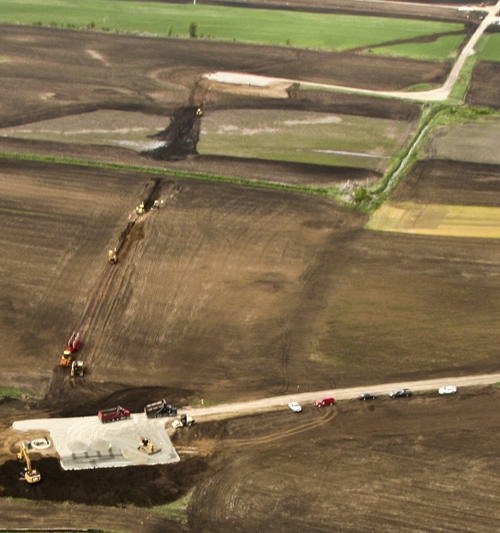
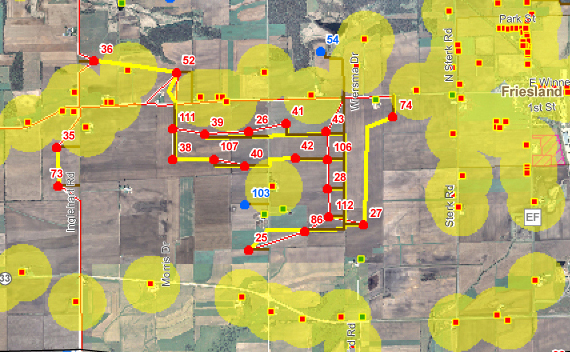
NOTE FROM THE BPWI RESEARCH NERD:
The project mentioned below was sited with the same setbacks and noise limits used to site the We Energies Glacier Hills project. (Detail maps above)
NO EASY SOLUTION TO WIND TURBINE PROBLEM
The Associated Press
VINALHAVEN, Maine (AP) -- The CEO of the electric cooperative that installed wind turbines on Maine's Vinalhaven island says there's disagreement over data suggesting they're too noisy. Fox Island Wind CEO George Baker says his experts dispute the findings of a Department of Environmental Protection consultant who says the turbines violate nighttime noise limits. State law sets a 45-decibel limit. Baker says his experts believe it was ambient noise from wind rustling through trees that exceeded 45 decibels, not the turbines themselves. Baker says it'll be a difficult issue to resolve. He told The Associated Press on Tuesday that slowing the turbine blades to lower the noise level by a couple of decibels may not make appease critics. And lowering it further could hurt the economic viability of the project.
5/4/10 DOUBLE FEATURE: Are wind turbines good for ag land? The Madison newspaper says yes, the Columbia County farmer says no. AND Don't tell it to the jury, here's your money, now keep quiet about wind turbine noise
WIND FARM WILL BE INVASIVE TO FARMS
SOURCE Wisconsin State Journal, host.madison.com
June 3, 2010
Regarding the State Journal editorial on May 25 titled “Wind turbines fit with farms”: As a resident of the town of Scott in northeast Columbia County, I can tell you the Glacier Hills Energy Park is not like the wind project at Montfort in Iowa County, which you featured in a photograph.
When Florida Power and Light first proposed a wind farm to our family, the idea was to place a row of turbines on an area we call the high line. This sounded like an idea worth pursuing. Seven years later, with WE Energies in control, the project has 90 very large turbines in a scattered pattern that are invasive to everyone’s environment in this area.
Contrary to what you think, there will be a large amount of very productive farm land out of production, or production will be compromised.
I heard very compelling testimony at a PSC hearing against this turbine arrangement. After the hearing, I felt the PSC would never allow this project. The evidence appears to have been disregarded.
It is alarming what a large company with government support can do to ordinary people. As a farming family, we could have turbines on our property in the future, but we now doubt if the money is worth the cost.
Sharon Prochnow, Cambria
SECOND FEATURE
COUPLE SETTLE LAWSUIT ON WIND TURBINE NOISE
By Kay Stephens and David Hurst
June 4, 2010
HOLLIDAYSBURG - The lawsuit between a Blair County couple and a company that operates Allegheny Ridge Wind Farm has been settled.
"All I can say about the resolution is that it's confidential," Pittsburgh attorney Bradley S. Tupi said Thursday. "I can't talk about the settlement."
Tupi represented Todd and Jill Stull, the Portage RD couple who sued in May 2008, complaining that the wind turbine noise had destroyed their quality of life.
They moved to the Juniata Township farm in 1992, and the turbine farm, which borders their property and spans five townships, went into operation in 2007.
The court case between the Stulls and Allegheny Ridge Wind Farm LLC was on track for a jury trial in July before Blair County Judge Daniel Milliron.
Tupi recently filed the decision on the settlement, with no details, at the Blair County Courthouse.
Allegheny Ridge attorney Jason Richey, who has been contesting the complaints and challenging the Stulls' requests for information, filed nothing at the courthouse regarding the settlement.
Richey and the Stulls did not return phone calls for comment.
Everyone involved in the case has agreed to the confidentiality clause, Tupi said.
The Portage Township supervisors were aware of the settlement and its confidentiality clause.
"The township didn't have to pay anything," Supervisor Kenneth Trimbath said. "This was between [Allegheny Ridge] and the Stulls."
The township paid about $420 in legal fees to attorney Walter Wall in connection with the lawsuit. It called the money well spent.
"We had our lawyers involved to keep us out of it," township Manager Bruce Brunett said, "And it worked."
Juniata Township supervisors previously tried to help resolve the Stulls' complaint by working with the wind farm operators and then by hiring an independent company to measure the turbine noise.
But after the study came back showing the wind turbine noise lower than levels permitted by ordinance, solicitor Michael Routch advised supervisors that the township was not in a position to do more.
Other Juniata Township residents, in addition to the Stulls, have complained about turbine noise from the Allegheny Ridge Wind Farm.
"Tell them to contact me," Tupi said.
SOME BACKGROUND ON THE LAWSUIT:
Wind experts duped local officials, Blue Knob couple’s lawsuit claims
December 24, 2008
HOLLIDAYSBURG — New documents filed in an ongoing civil lawsuit by a Portage-area couple against the Allegheny Ridge Wind Farm say that wind energy experts duped local officials into believing the turbine sound was insignificant.
Todd and Jill Stull of the Blue Knob area say that developer Gamesa Energy USA and owner Babcock & Brown misled local officials by supporting development of an ordinance addressing higher noise levels.
The Stulls filed an amended suit Tuesday. The ordinance establishes a maximum sound level of 45 decibels and does not address the lower frequency noises, including turbine vibration that is said to cause health and other problems suffered by the Stulls.
Mrs. Stull, holding a bottle of water inside her home, can feel the turbines’ vibrations throughout her hand, their lawyer said.
Nine of the 40 windmills in Phase One of the planned three-phase wind farm are within a mile of the Stulls’ home, which is situated where the Portage, Juniata and Greenfield township lines converge.
Three years ago, ordinances established that turbines must be a minimum 2,000 feet from residences and not exceed a noise level of 45 decibels. They were adopted by Portage, Washington and Cresson townships, Cambria County, and Juniata and Greenfield townships, Blair County.
The Stulls filed the civil suit in April and, earlier this month, while a Blair judge kept the lawsuit intact, he dismissed several counts, including one claim that Gamesa created a public nuisance.
He allowed to stand a claim that Allegheny Ridge created a private nuisance.
But Pittsburgh Bradley Tupi, representing the Stulls, was told by Judge Daniel Milliron to provide additional evidence in order for a fraudulent misrepresentation claim to stand.
In the amendment, Tupi claimed the companies knew the turbines would be noisy and failed to tell local officials – whom he said were depending on the wind companies for guidance in developing local laws.
“Brian Lammers and/or other Allegheny representatives told the Portage Township officials that the wind turbines would be quiet,” Tupi said in the lawsuit, referring to a May 2005 conversation with then-Supervisors James Decort and Richard Olshavsky.
“Lammers told Portage Township officials that there would be no noise or minimal noise from the wind turbines,” Tupi said in the document.
The Stulls said the turbines have had a significantly negative impact on their sleep, health, quality of life and enjoyment of their 100-acre property purchased in 1992.
They describe the sound from the equipment as a “whooshing” and “screeching.’’
Lammers told officials the windmill noise would be equivalent to a refrigerator.
Representatives from Babcock & Brown and Gamesa could not be immediately reached for comment Wednesday. In the past, Gamesa officials have said they would not comment on the lawsuit.
HAVE YOU REACHED OUT AND TOUCHED YOUR PSC TODAY?
The PSC is asking for public comment on the recently approved draft rules for siting wind turbines in our state. The setback recommended in this draft is 1250 feet from non-participating homes.
CLICK HERE and type in docket number 1-AC-231 to read what's been posted so far.
CLICK HERE to leave a comment on the Wind Siting Council Docket
1/22/10 Dear Columbia County, Did you know those 90 Glacier Hills turbines come with an automatic extra 18 turbine 'Country Cousin'?
 PSC STILL SORTING OUT DETAILS OF COLUMBIA COUNTY WIND FARM
PSC STILL SORTING OUT DETAILS OF COLUMBIA COUNTY WIND FARM
By Lyn Jerde, Daily Register, portagedailyregister.com
January 21 2010
Within days, the Public Service Commission of Wisconsin will finalize its list of conditions for the construction of a wind farm in northeast Columbia County.
But officials of We Energies already are planning where the turbines will go and determining whether the PSC’s conditions will allow erecting all 90 of them.
On Jan. 11, the PSC approved a certificate of public convenience and necessity for the wind farm, called Glacier Hills Wind Park, on about 17,300 acres of farmland in the towns of Scott and Randolph.
The proposal called for 90 turbines, each about 400 feet tall, capable of generating up to 207 megawatts of electricity.
The commission met again Wednesday, this time to draft the specifics of conditions that the commissioners had discussed Jan. 11 before granting approval for the project.
PSC spokeswoman Teresa Smith said Monday is the deadline for the formal list of conditions to be in the hands of We officials. The list is undergoing final editing, based on the discussion of the commission at its meeting in Madison on Wednesday.
We Energies spokesman Brian Manthey said he listened to the live electronic broadcast of Wednesday’s meeting and has heard nothing in the proposed conditions that could stall or stop the utility’s plans to start construction late this spring.
The most challenging condition, however, is a minimum 1,250-foot setback between each turbine and the property of landowners who are not leasing any land for the turbines, Manthey said.
The original proposal, with 90 preferred turbine sites and 28 alternate sites, included a minimum setback of 1,000 feet from nonparticipating landowners, he said.
The hope, he added, is that “preferred sites” that are closer than 1,250 feet can be replaced with alternate sites that meet the setback requirement, thus allowing all 90 turbines to be built. It’s too early, however, to determine whether the setback rules will result in fewer turbines going up, he said.
“Hopefully, we’ll be up to that number of 90,” he said, “but it might be a different 90 than we’d planned.”
The PSC’s condition limiting the noise of the turbines also is a factor, Manthey said – not only in where they are located, but also in the type of turbines eventually used in Glacier Hills.
The commissioners set noise limits of 50 decibels day and night during colder months and 50 decibels by day and 45 decibels by night during the warmer months when people often like to sleep with their windows open.
Minimizing noise is one reason why We Energies is considering turbines capable of generating 1.8 megawatts each, for a total of 162 megawatts. Manthey noted that these turbines would be about as tall as the ones that would, all together, generate the 207-megawatt maximum allowed by the PSC. The difference in the turbines, which accounts for the difference in the noise they create, is the size of the attached generators.
No final decision has been made regarding the generation capacity of the turbines that soon will be part of Columbia County’s skyline.
But even if the project were to generate the maximum power allowed, Manthey said, We Energies still would need other renewable energy projects to meet the state requirement of generating 10 percent of its electricity from renewable resources by 2015. (Those standards might go up. There’s legislation pending in Wisconsin to raise the renewable energy standards for utilities to 20 percent by 2020 and 25 percent by 2025.)
We Energies has another renewable project pending – a power plant built on the premises of a paper mill near Rothschild, south of Wausau, that would burn waste wood left over from the paper-making process.
Meanwhile, Manthey said, it’s not certain when Columbia County residents can look for trucks carrying the huge wind turbine components down the country roads. The initial construction work will entail site preparation and foundation building. Glacier Hills is expected to be up and running by late 2011.
NOTE FROM THE BPWI RESEARCH NERD: According to following press release, the 90 turbine Glacier Hills wind farm mentioned above has an 18 turbine "country cousin."
New 30-Megawatt Wind Project in Columbia County Approved
PRESS RELEASE: E Wind LLC last week received approval to proceed with its 30-megawatt, 18-turbine wind project near Friesland, Wisconsin and the recently approved Glacier Hills wind project to be built and owned by WE Energies.
E Wind LLC is the country cousin to the larger Glacier Hills project, being developed by some local landowners and entrepreneurs who are determined to not let all renewable energy (and money) go to the big companies. Bob Lange, an E Wind member who farms near Columbus remarked, "I was involved in the development of the UWGP ethanol plant in Friesland and saw all these wind measurement towers being installed in the area by several large wind developers; that got me thinking that wind energy might be the next renewable energy of choice for the area." Bob found a few others to join him and off they set to put together a wind project. It included finding willing landowners to lease their property for turbines, paying the transmission owners to study the electrical connection of their project, installing a 200-foot tall wind measurement tower, and approaching the Town of Randolph about receiving permission to build the project.
Wes Slaymaker, P.E., of WES Engineering LLC, a Madison-based wind energy consulting company who is acting as the E Wind LLC project engineer, commented, "We staked some possible turbine locations in the winter of 2008 and spent the next year moving those locations around to address all the concerns of the landowners and community members." Later E Wind hired Cullen Weston Pines and Bach LLP, a Madison law firm, to assist the project with negotiating a development agreement with the Town of Randolph.
Unfortunately, E Wind’s timing was poor as the Glacier Hills project had recently been announced by We Energies and the local area was inflamed with concerns regarding how that large wind project would affect their homes and communities. The E Wind members spent plenty of their evenings attending town and village meetings. They hoped to get some sympathy from the area residents as the local project and eventually convinced the town to vote to approve the E Wind project, contingent upon the approval of the larger Glacier Hills project.
1/10/10 Monday, Monday. The PSC decides on the fate of residents whose homes are inside of the Glacier Hills Project
WISCONSIN WIND TURBINE NOISE LOG, TOWN OF BROWNSVILLE, WI.Sunday, January 10, 2010:7:45AM. Wind SW 6 knts, 18 rpms @ 1000’ from turbine 4. dBA 51.8, dBC 67.0. Wind is low, blade speed high, low ambient sound, therefore very loud turbine sounds.Turbines 4, 6 & 73 loudest, but also I hear 3a, 74a +. My wife did not sleep well and was up several times “trying” to get tired. Two other nights this week similar happenings for her. I woke up with a headache and it continues. Again, it is rare for me to have a headache.I would guess my cortisol level is again high as the last week or so my food seems like it is in my throat and I need to keep drinking water to keep the food down. My weight is getting close to my all time high.3:50 PM Wind SW, 18.6 rpms 14 knts, peak gusts 21. The sound of the wind is now loud so it covers much of the turbine sounds even though the jet sound is still heard. My wife just asked if the wind is strong because the ringing in her ears is loud.Yes, the volume of the ringing sound varies."---Gerry Meyer, Invenergy Forward Energy wind farm resident, Fond du Lac County, Wisconsin
"Let me be clear, however, as to why I’m here. I’m here because of people who are suffering as a consequence of being near wind turbines. Adverse health effects are occurring as we speak.
My proposal is this: Authoritative guidelines must be developed, and the only way to do that is a well-designed epidemiological study conducted by arm’s length investigators, mutually agreeable to all sides. That must be done – as well as check for low frequency noise. In the meantime, let us listen to and help the victims. Anything less would be an abandonment of responsibility by government."
---Testimony of Dr. Robert McMurtry to the Ontario Legislative Assembly Standing Committee. [Click here to read more ]
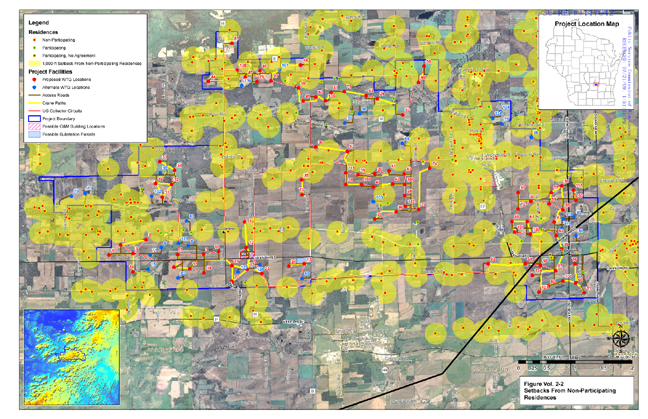 Glacier Hills Wind Farm: Yellow circles indicate 1000 setback around non-paticipating homesPSC ruling expected on Glacier Hills
Glacier Hills Wind Farm: Yellow circles indicate 1000 setback around non-paticipating homesPSC ruling expected on Glacier HillsState regulators on Monday will rule on We Energies' $413.5 million proposal to build the largest wind farm in the state.
The Milwaukee utility is proposing a 90-turbine wind power project, the Glacier Hills Wind Park, northeast of Madison. It would be the largest wind farm in the state, slightly bigger than the 88-turbine Blue Sky Green Field wind farm We Energies began operating near Fond du Lac last year.
Glacier Hills would generate enough power over a year to supply 45,000 typical homes, the utility says.
The proposal has run into opposition from local residents who are concerned about the impact of wind turbines on their property values as well as a Chicago wind-power developer that is proposing an alternative project.
We Energies needs this and other renewable energy projects to be built in order to comply with a state mandate that 10% of Wisconsin's electricity come from renewable power sources by 2015.
A provision in the proposed Clean Energy Jobs Act, introduced this week, would accelerate that mandate, requiring the utility to meet that 2015 requirement two years earlier, in 2013. The bill would require that the mandate ramp up so that 25% of the state's power supply would come from wind turbines, biomass projects and other renewable power sources by 2025.
In the Glacier Hills case, the environmental group Clean Wisconsin is calling on the Public Service Commission to require the Milwaukee utility to shut down some of its older coal-fired power plants as a way to help it comply with renewable power mandates.
Shutdowns would make it easier to attain renewable targets and may be in order, the group says, because decreasing power sales linked to the recession and the addition of power plants in Port Washington and Oak Creek mean the state no longer faces power supply challenges.
The state Public Service Commission last month agreed to open an inquiry into whether the state's utilities should have to shut down or idle older plants because of the state has an ample supply of power.
Meanwhile, Invenergy LLC of Chicago is asking that the commission, if it approves the We Energies project, also require the utility to enter into negotiations to buy power from Invenergy's proposed wind farm in southern Brown County. Invenergy built the Forward Wind Energy Center near the Horicon Marsh.
We Energies spokesman Brian Manthey said the utility believes it has made the case for Glacier Hills.
"It's definitely one of the best locations in the state to build a wind farm," Manthey said. There's a nearby link to the high-voltage transmission system, he said, and "it's a good wind resource and low population density. That all points to why this is a very, very good location."
